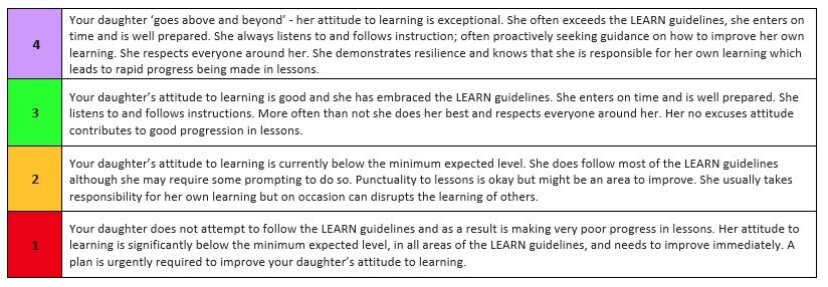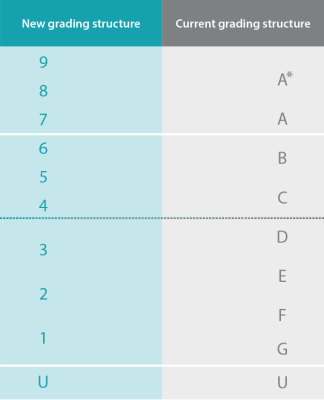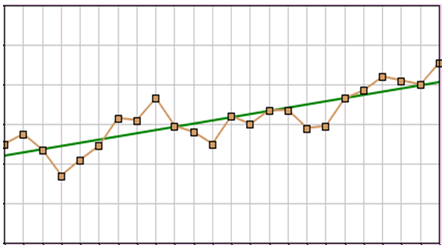Reports and Targets
Understanding Reports
There are many ways to track and report home student's attainment, and each school in England can decide on the method that they feel is most meaningful for teachers, parents/carers and students.
At FSG a full report for each student, with attendance information, target grades, current attainment, ATL scores and teacher comments is published once a year. A further ‘data dashboard’ (data only) is published over the course of the academic year and all year groups, bar examination years, have an end of year report which combines a data dashboard with a tutor comment to recognise and celebrate all the other achievements outside of the classroom over the school year. In combination with parents evening, parents therefore have four scheduled opportunities for feedback on progress made in school over the year. There are, of course, more frequent updates on achievement and behaviour available via the SIMS ParentApp and parents are also encouraged to contact the school should any concerns or queries arise.
On reports we give context to parents and carers using colour coding on four measures:
- How well their teacher feels that they are progressing in their learning and current attainment
- Their Attitude to Learning score, which tracks their engagement with their learning and reflects their behaviour, attitude, focus and contribution in lessons.
- Homework - a measure of engagement with homework assigned by subject teachers, which reflects effort and completion rates.
- Their Attendance
When you read your daughter’s report it is just as important to focus on the colour of each box as the numbers within it.
Progress and current attainment - what the colour coding means:
 Attitude to Learning – what the colour coding means:
Attitude to Learning – what the colour coding means:

Homework - what the colour coding means:

Attendance - what the colour coding means:
How do I know how my daughter is progressing?
Academic targets in years 7 - 11 focus solely on progress towards GCSE grades.
In years 7 and 8 however, students are still some way off GCSE and indeed have yet to even to decide which subjects to study to GCSE! For these reasons we do not specify individual ‘target’ grades for students in years 7 and 8 and instead suggest a notional GCSE grade to work towards. This is based on how students of similar ability nationally achieved in the past and/or on CATS tests. Reports in years 7 and 8 therefore simply state that ‘in the past students of a similar ability went on to achieve mainly Grades 6 or 7 in their GCSE examinations’. For these reports traffic light colour coding shows whether the student is ‘on or above’, ‘just below/broadly in line’ or ‘below expectation’ via GREEN/AMBER/RED respectively.
In years 9, 10 and 11 students have now determined the subjects they will study to GCSE and are set individual target grades for each individual subject that they study.
Until 2018, GCSEs grades were awarded with letter classifications. They are now numerical, but we can approximate what a numerical grade approximates to in the old system as follows:

Source – Ofqual , 2018
Assessment is based not only on results obtained in recent tests, but also on performance in class and in homework assignments. It therefore provides a broader, more rounded picture of current attainment – rather than just a snapshot of one test on one day. For that reason, the latest class based test result may differ slightly from the grade reported home.
Reports really provide just a brief snapshot for parents. Your daughter will have much more continuous, more formative, and more useful assessment day-to-day in school to support her to progress. Written reports provide a level of feedback too – as do parents evenings - but data dashboards are really just a quick visual snapshot for parents at the end of the year to see that all is in hand – or not!?
Understanding Target Setting
The Folkestone School for Girls aims to set challenging but achievable targets for students. Targets set are always based on the latest national information available and the Department for Education has one of the largest educational databases in the world to facilitate this. This records how students achieve at various stages of their journey through school. Levels achieved at the end of primary school are compared with the GCSE results achieved by the very same students’ years later. This allows estimated grades to be produced for students currently preparing for GCSE. Of course, there a range of possible grades for any ability group nationally – some students will achieve 9, some 8, some 7, some a 5, some might falter and some might ‘fail’ etc. but it is possible to estimate the average grade that students of a particular ability attain.
The word ‘target’ though, of course, suggests a level of challenge – rather than simply achieving in line with similar students. That said, it is equally true that not everyone can be ‘above average’. So, we seek to make targets challenging but achievable. So, if your daughter is targeted a grade 7 in History, for example, this is for one of two possible reasons. Either:
1) Because most students who achieved the exact same levels as she did at the end of primary school went on to achieve a grade 7 in History.
Or
2) Whilst her most likely grade is 6, she stands a good chance of being able to achieve 7 because in the past a significant number of similar ability students nationally have gone onto achieve grade 7.
In this way targets set, we believe, strike the correct balance between challenge and achievability. Students and parents are encouraged to discuss targets – for some they will be something to aim for, for others they may be something to beat! Not everyone will achieve their targets, or perhaps in some subjects but not others. Some students may, for instance, be focussed entirely on a career that requires maths and sciences; they might be less interested in other subjects and might decide that for their ambitions and aspirations, Maths and Sciences hold the key. They won’t want to do badly in the others, for sure, but they will really want to excel where it’s needed.
Flight Path
Essentially our targets are based on a ‘flight path’ idea. Students start in Year 7 and will make progress throughout their school career as they journey towards GCSE. As students all have different starting points, they all therefore have different end points; they are all aiming for different outcomes and thus they all have different targets! Whilst the national media obsesses about Grade 9s, for some students a grade 6 in History or a Grade 4 in Maths may have been equally hard fought and hard won as a grade 8 or 9 for another student – and so we recognise and celebrate all achievements; all progress made equally. We also must acknowledge that progress is rarely such a straight line; the reality is that we all have little peaks and troughs along the way – a ‘spikier profile’ based on particular topics covered perhaps, attendance, stuff going on at home from time-to-time, hormones even; there are lots of things that impact on us as individuals along the way! It’s for that reason that the odd amber, perhaps even the odd red shouldn’t necessarily induce panic; maybe just something to watch!
Do we set targets of Grade 9?
Brief answer is No! We don’t want students who achieve Grade 8 appearing as reds! It is inconceivable that a student achieving 10 X Grade 8s (10 x Grade A* in old money) should be seen as anything other than a triumph! Not appear as a sea of red. We certainly feel that students and parents should celebrate that sort of level of achievement for what it is – stunning! However, we also don’t want to limit ambition and so student targets at this sort of level are set as ‘8 or above’.
Do targets set change over time?
As a general rule we try not to continually adjust student targets. Girls need a clear goal to aim for and if this is constantly changing this can be disruptive. However, we are in the midst of considerable change in education with fairly new specification, new grading structures, new performance tables and of course the absence of any public exam information over the covid years to contend with. As schools have been adjusting to this there has been considerable turbulence over the past few years in terms of exam results nationally. This is likely to continue to be the case for the next few years too. So, targets may change – based on the last set of public examination results achieved nationally.


